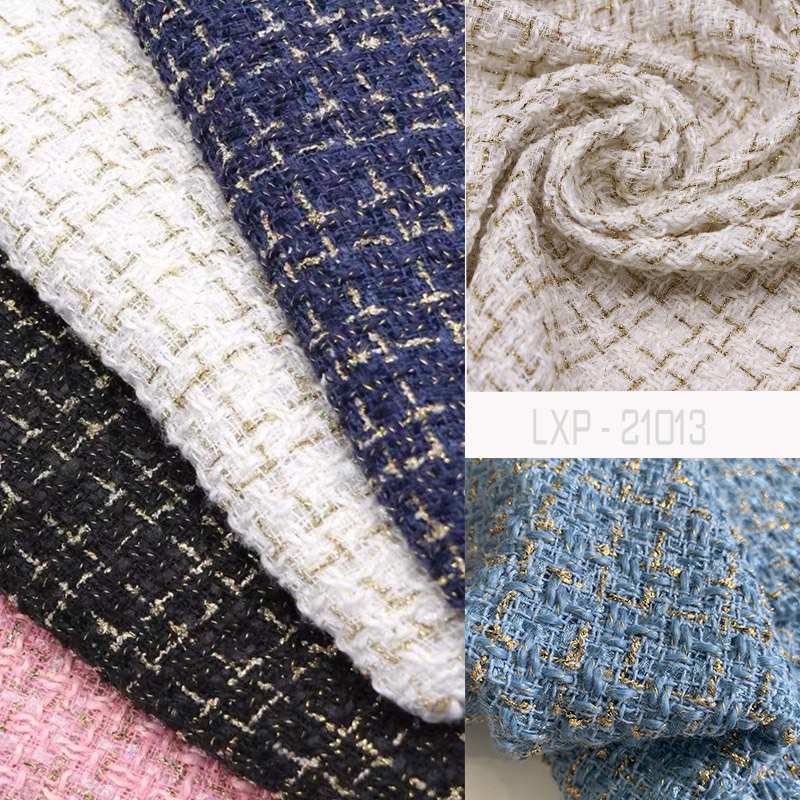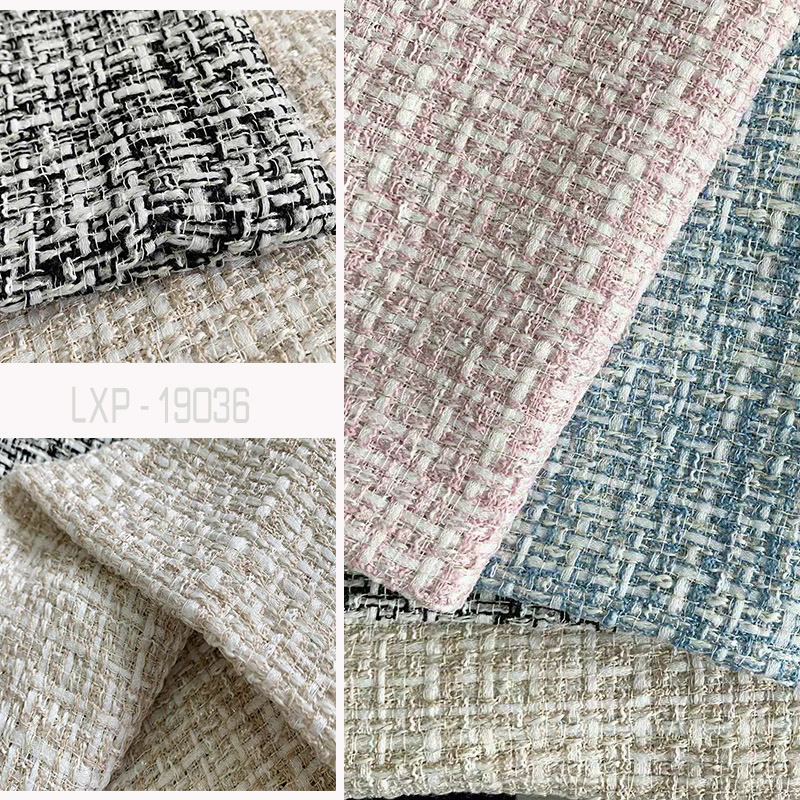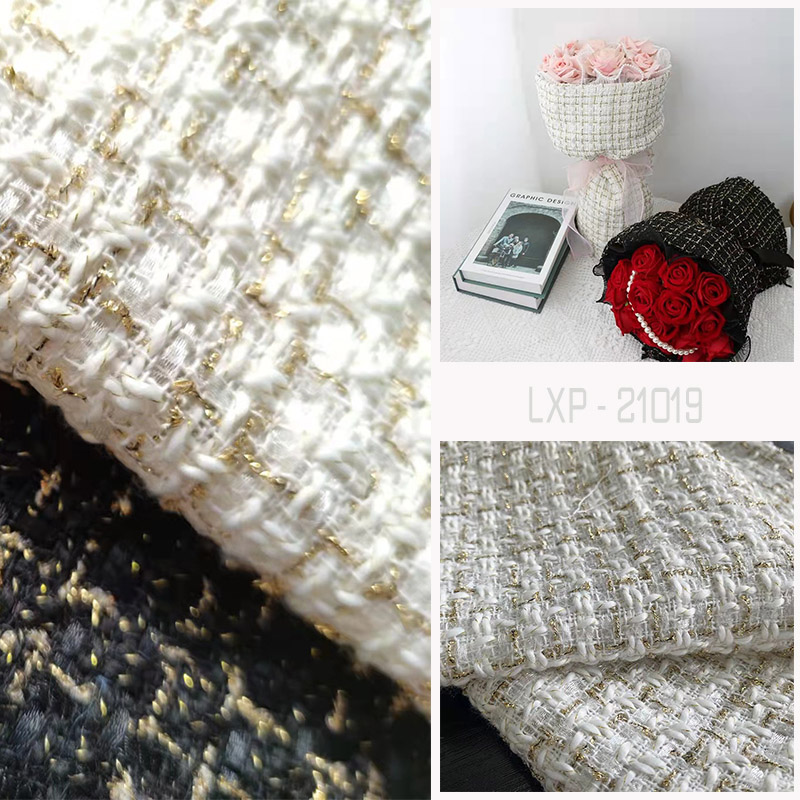Wholesale Woven Fabric Houndstooth Polyester Women's Coat Woven Breathable Tweed Upholstery Fabric By The Yard
Tweed upholstery fabric by the yard。
Tweed upholstery fabric is a rough woven fabric usually made from wool. The fibers can be woven using a plain weave or twill weaves, Moreover, Tweed is an extremely warm, hard-wearing fabric that is thick and stiff. For example, one type of tweed fabric--wool tweed, is often woven using different colored threads to achieve dynamic patterns and colors, frequently with small squares and vertical lines.
In the beginning, Tweed was originally called “tweel,” which is the Scots word for twill, the most popular weaving technique for making tweed. The name, according to lore, came about when a London merchant misinterpreted the name “tweel” for “tweed,” thinking the fabric was named for the River Tweed in Scotland. The name stuck and the fabric has been called tweed since. And the history of tweed fabric originated in Scotland and Ireland, worn commonly by farmers. Tweed became popular with the upper classes across the British Isles after 1848, when Prince Albert purchased Balmoral Castle in Scotland and designed the unique Balmoral tweed. Each highland estate began to make it's own “estate tweeds” to differentiate itself during hunting expeditions and other outdoor activities.
There are many different ways to make tweed fabric, and different types of tweed are named for the sheep they’re made from, where the tweed is made, or after the type of weaving technique or pattern. Almost have 8 Different Types of Tweed:
1. Harris Tweed. Harris tweed is a legally-protected type of tweed made in the Outer Hebrides, an archipelago off the northern coast of Scotland. According to the Harris Tweed Act of 1993, Harris tweed is strictly defined as: “Handwoven by the islanders at their homes in the Outer Hebrides, finished in the Outer Hebrides, and made from pure virgin wool dyed and spun in the Outer Hebrides.”
2. Donegal tweed. Donegal tweed is named for the Irish county of Donegal, where it originated. This is one of the most popular types of tweed in the world, and it is distinguished by its rainbow-colored specks of yarn throughout the knobby surface.
3. Saxony tweed. Saxony tweed from merino sheep, originally made in Saxony, Germany. The tweed is very soft and smooth, due to the nature of merino wool.
4. Herringbone tweed. Herringbone is a broken twill weave that produces a pattern of V’s on the surface of the fabric. Some say the herringbone pattern looks like fish bones, hence the name.
5. Shetland tweed. Shetland tweed is named for the sheep from the Shetland Islands, a group of islands far off the northeastern coast of Scotland. The wool is lighter and more delicate, creating a lighter-weight, casual tweed.
6. Barleycorn tweed. The weave of a barleycorn tweed gives the effect and look of barleycorn kernels on the surface of the fabric. It’s a very dynamic pattern and has a slightly bumpy feel.
7. Cheviot tweed. Cheviot tweed is named for the type of sheep used to make the wool, from the Cheviot Hills in the Scottish borders region. It is generally rougher and heavier than other types of tweed.
8. Overcheck twill. Overcheck twill is a plain twill fabric with a large checked design in a contrasting color completing the tweed pattern.
As a result of its warmth and rough and distinctive texture. Tweed is very popular for suits and jackets, which were originally made out of the material for hunting activities. and usually have three

Different ways to use:
1. Tweed jackets. Tweed sport coats for hunting were one of the first uses of the fabric, and the tradition continues today, as tweed patterns populate many blazers and coats as both a practical and fashion statement. Tweed coats are extremely warm and long-lasting.
2. Tweed suit. Full tweed suits are also popular and can look extremely distinctive when accessorized well. It’s a classic look, and the textile provides great warmth and a vintage appeal.
3. Accessories. Tweed hats and bags are also a common use of fabric. Tweed caps are characteristic of highland farmers and weavers, but they’re also a nice fashion statement.
Conclusion for how to use tweed fabric can be used in Countrywear, Outerwear, Jackets for women, Jackets for men, Skirts, Suits, Waistcoats or vests, Dresses, Trousers, Hats & caps, Bags & accessories, and even tweed shoes, and this also touches on tweed's use for furniture or furnishings.
About how to care for tweed fabric, Most wool products are recommended to be dry cleaned only. However, at your own risk, you may find gentle hand-washing in cool but never hot water is an alternative. And this is certainly best for special wools such as cashmere which would not normally be trusted for dry-cleaning. If hand washing, make sure this is suitable for every part of your garment. For example, jackets may be constructed with details like interfacing, lining, and shoulder pads, which washing could damage. After washing, lay it flat to dry, to avoid stretching. Tweeds are generally wrinkle-resistant, so ironing is unnecessary. If buyers don't want to hand-wash, your garment might be freshened with steaming, which kills most germs and bacteria and helps eliminate odors. Or localized stains can be removed carefully with a mild detergent or other suitable topical treatment. Carefully blot at fresh spills with a towel. Do not rub! Spot-cleaning is the best option for most stains on tweed. For storage, the ideal for tweed fabric and clothing would be a cedar chest. But any cool dry place is fine, as long as your garments are protected from moths. If storing for long, we recommend bagging. In particular, avoid anywhere damp; relative humidity should never exceed 50%. Wool jackets are best hung on thick or padded hangers to help keep their shape.


